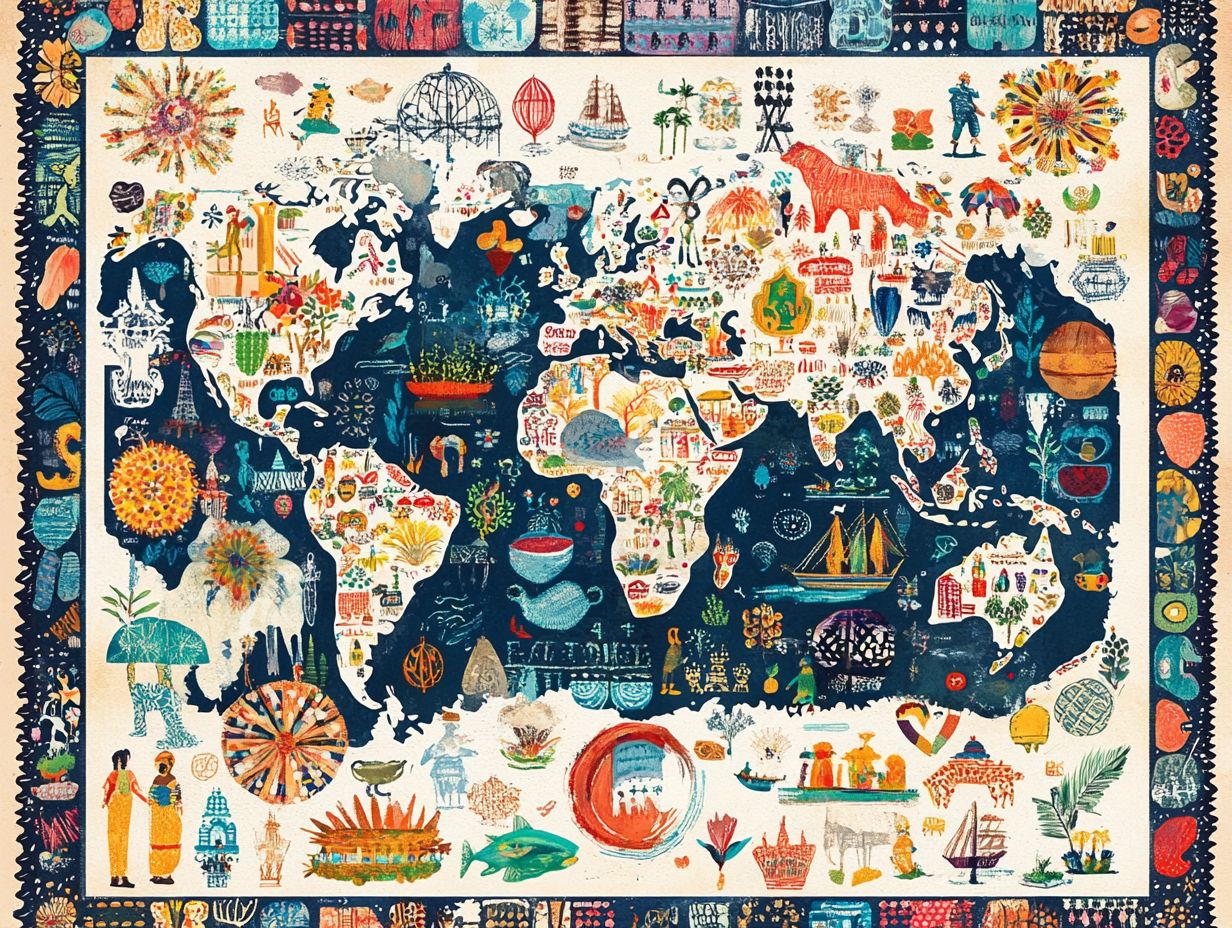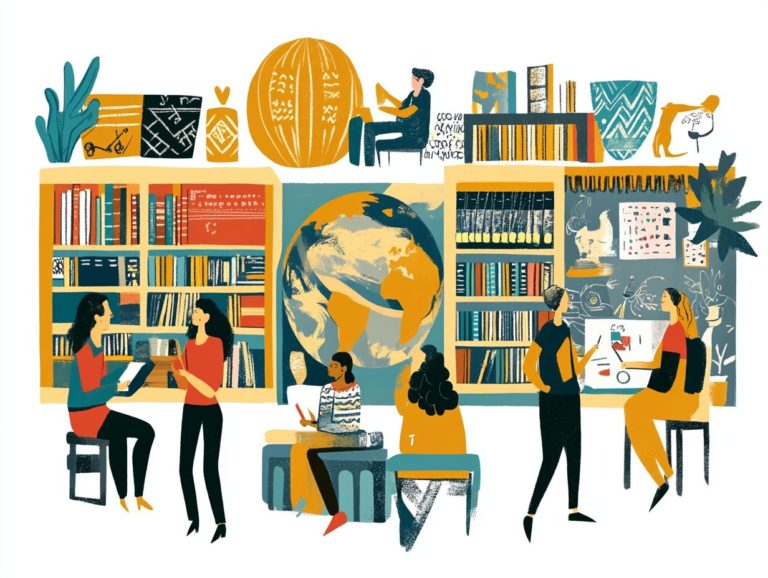7 cultural influences on global languages
Language is a living tapestry, intricately woven from the threads of culture, history, and human interaction. Get ready to explore how seven pivotal cultural influences colonization and imperialism, trade and commerce, migration, technological advancements, cultural exchanges, religion, and globalization shape languages across the globe!
Each of these elements carries both positive and negative effects, driving the evolution of languages in ways that mirror our shared humanity.
Prepare to uncover how these influences intertwine and exemplify their impact on specific languages. Reflect on strategies to preserve linguistic diversity in an ever-changing world.
Contents
- Key Takeaways:
- 1. Colonization and Imperialism
- 2. Trade and Commerce
- 3. Migration and Immigration
- 4. Technological Advancements
- 5. Cultural Exchanges and Interactions
- 6. Religion and Missionary Work
- 7. Globalization and Media
- How Do These Influences Affect Language?
- What Are the Positive Effects of Cultural Influences on Language?
- What Are the Negative Effects of Cultural Influences on Language?
- How Do Cultural Influences Shape the Evolution of Language?
- What Are Some Examples of Cultural Influences on Specific Languages?
- How Can We Preserve the Diversity of Languages in the Face of Cultural Influences?
- Frequently Asked Questions
- What are the 7 cultural influences on global languages?
- How does colonization influence global languages?
- In what ways does migration affect global languages?
- How does trade influence the development of global languages?
- In what ways does technology influence global languages?
- How does media impact global languages?
- How does education influence global languages?
Key Takeaways:

Cultural influences like colonization have changed global languages, adding new words and grammar rules. Technology has transformed how we communicate and use language.
Migration and immigration have led to the spread of languages, resulting in the incorporation of words and phrases from different cultures into global languages.
1. Colonization and Imperialism
The impact of colonization and imperialism on language and culture has been nothing short of profound. These processes shape identity, values, and modes of communication within communities and beyond.
Big changes in cultural expressions have occurred, wielding powerful influences on the variety of languages in a community and the transmission of traditions.
For instance, the spread of English and Spanish due to colonial efforts was not just about altering local dialects. It introduced concepts and ideas that were previously non-existent.
As indigenous communities embraced these foreign tongues, they often fused them with their own languages. This resulted in hybrid forms that beautifully encapsulate both tradition and modernity.
Linguistic evolution profoundly affected cultural values. Many societies wrestled with the loss of traditional practices while redefining their identities in new social contexts.
Such dynamics cultivated community interactions heavily influenced by dominant powers. This left behind a legacy of both cultural assimilation and resilience that continues to resonate in contemporary expressions and relationships.
2. Trade and Commerce
Trade and commerce have undeniably shaped cultural interactions and communication. They enable the exchange of goods, ideas, languages, and traditions among diverse communities.
Through vibrant exchanges, influential trade routes like the Silk Road and the Spice Route sparked linguistic innovations. Traders from various regions engaged and shared their languages.
For example, when Arabic and Persian traders crossed paths, they cultivated a rich vocabulary centered around maritime trade. These interactions often led to borrowing terms related to daily life, spirituality, and technology.
This fusion of languages did more than just enhance communication. It paved the way for a deeper understanding of cultural nuances and traditions, crafting a more interconnected world through shared experiences.
3. Migration and Immigration
Migration and immigration play a pivotal role in enriching cultural diversity. They transform communities and identities as individuals introduce their languages, beliefs, and customs into new environments.
This beautiful blending of cultures often challenges established norms. It creates a vibrant setting where different languages coexist and intertwine, weaving a rich tapestry of communication.
As you navigate your new surroundings, the languages you speak become vital in preserving your cultural heritage. They allow you to maintain a sense of identity amidst the shifts that come with change.
Introducing varied linguistic expressions not only enhances societal understanding but also fosters empathy among diverse groups.
When communities engage with a variety of languages, they discover new forms of expression and cultivate a deeper respect for one another s backgrounds. This paves the way for a more harmonious and interconnected society.
4. Technological Advancements
Technological advancements have transformed communication, introducing innovative methods for expression and interaction that shape language and cultural practices around the globe.
As you increasingly turn to online education platforms and social media, the way you learn new languages and connect with diverse cultures has dramatically evolved. This accessibility opens the door to global conversations.
Engaging with native speakers in real-time enhances linguistic skills far more effectively than traditional methods ever could.
While these tools are invaluable for bridging gaps and fostering understanding, they also present challenges to linguistic diversity. Many smaller languages are at risk of fading into obscurity as dominant languages, often propelled by popular technological platforms, overshadow them.
This raises important concerns about cultural preservation in an increasingly homogenized digital landscape.
5. Cultural Exchanges and Interactions

Cultural exchanges play a crucial role in shaping societal values and traditions. They cultivate a vibrant tapestry of global diversity.
These exchanges manifest in various forms, from intricate dance styles showcased at folk festivals to fusion cuisines that blend flavors from distinct regions. They illustrate how different cultures communicate their identities through culinary creativity.
Consider the globalization of music genres like jazz or reggae; they beautifully demonstrate how rhythm and melody can foster cultural appreciation and collaboration.
Such interactions enrich personal experiences and highlight the importance of linguistic diversity. They deepen your understanding of dialects and phrases that embody unique cultural nuances, ultimately promoting a more inclusive worldview.
6. Religion and Missionary Work
Religion and missionary work have long served as conduits for cultural transmission, influencing language by infusing new beliefs, values, and expressions into diverse communities.
This dynamic interaction is vividly illustrated in the evolution of proverbs, idioms, and rituals that embody the core principles of various faiths.
Take, for instance, the impact of Christian missionaries in many African nations. Their arrival often led to the integration of biblical phrases into local languages, enriching the lexical tapestry.
The phrase “the good Samaritan,” for example, is repurposed within indigenous contexts to highlight compassion, intricately weaving faith into the fabric of everyday life.
In parts of Asia, Buddhist teachings similarly shape language, giving rise to expressions that convey mindfulness and harmony. This demonstrates how spiritual beliefs resonate through dialects and local customs.
These exchanges make languages richer and more vibrant while also playing a crucial role in preserving and transforming cultural identities.
7. Globalization and Media
Globalization and media have significantly accelerated the exchange of cultural influences, shaping your language and communication practices while fostering a deeper understanding of diverse identities and expressions.
Local languages often enrich with borrowed terms and phrases, resulting in captivating hybridization that reflects both global trends and regional traditions.
This blending can give rise to new dialects or slang that resonate with youth, emphasizing shared experiences that bridge cultural divides.
The representation of various ethnic groups in films, music, and online platforms actively influences society’s views, challenging stereotypes and reinforcing existing ones.
These dynamics illuminate the intricate relationship between media, language, and cultural perceptions, showcasing how the digital landscape serves as a catalyst for evolving modes of expression across the globe.
How Do These Influences Affect Language?
The myriad influences of colonization, trade, migration, and technology play a critical role in shaping your language. They impact how your community interacts, communicates, and expresses its identity.
As you encounter new customs, ideas, and people, your linguistic framework adapts. This leads to the incorporation of diverse vocabulary, borrowed phrases, and entirely fresh idioms.
This phenomenon transcends mere word changes; it reflects a dynamic interplay between language and its context. For instance, when your community adopts tech-savvy terminologies due to globalization, it reshapes traditional modes of communication.
Such transformations reveal how language serves as both a mirror and a catalyst for broader cultural shifts. This illumination shows the underlying values, beliefs, and collective identities that evolve with each new influence.
What Are the Positive Effects of Cultural Influences on Language?
Cultural influences can enrich language and foster innovation. In urban environments where different cultures converge, this melting pot leads to the hybridization of languages.
For example, take Spanglish a lively mix of Spanish and English that thrives in many Hispanic communities across the United States. This linguistic crossover introduces fresh vocabulary, such as “parquear” (to park) and “lunchar” (to have lunch), which are slang terms used within this context.
Additionally, this blend strengthens community bonds through relatable communication. The advent of technology has also given rise to terms like “selfie” and “hashtag,” which, rooted in specific cultural contexts, have woven themselves into everyday conversations across diverse settings.
These phenomena show how language evolves through cultural interactions, enriching societal discourse and promoting a deeper sense of mutual understanding.
What Are the Negative Effects of Cultural Influences on Language?

Cultural influences can enrich language, but they also bring along some less desirable consequences. These include language loss, diluted identity, and the erosion of traditional values within communities.
You can often witness the decline of certain languages through specific case studies, where dominant cultures overshadow local dialects. This results in significant shifts in community dynamics.
For example, in areas where globalization reigns supreme, indigenous languages face increasing pressure. Younger generations may embrace the dominant language instead, leading to profound implications for cultural identity.
When a language disappears, it takes unique perspectives on understanding the world, along with traditions and shared histories essential for community cohesion.
By emphasizing the preservation of linguistic heritage, you can nurture a sense of belonging and cultural pride. This ultimately fosters resilience against the forces of homogenization that dominant cultures impose.
How Do Cultural Influences Shape the Evolution of Language?
Cultural influences play a pivotal role in shaping the evolution of language. They impact how expressions, idioms, and proverbs are passed down and adapted through generations.
These linguistic shifts often mirror broader historical contexts, like migration patterns, colonization, and technological advancements. All of these introduce fresh vocabulary and modify grammatical structures.
As communities engage through trade or cultural exchanges, their languages evolve, leading to the incorporation of foreign words or concepts.
Local practices such as storytelling traditions, festivals, and communal gatherings are essential for preserving vernacular forms and nurturing linguistic creativity.
This dynamic interplay between culture and language not only reflects the identity of a community but also illustrates how collective practices influence language usage and understanding over time.
What Are Some Examples of Cultural Influences on Specific Languages?
Languages like English, Spanish, and Chinese serve as prime examples of how cultural influences drive changes in language over time.
Take English, for instance. It has dramatically transformed due to its interaction with Norman French, resulting in a rich vocabulary that includes terms like “court” and “jury.”
Similarly, Spanish has seamlessly integrated indigenous words from Latin American cultures. Words like “chocolate” and “tomato” have become staples in everyday conversation.
On another front, the evolution of Chinese has welcomed English terms, especially in technology and business. This fusion signifies a blend of ideas and practices that transcend geographical boundaries.
Such interactions not only give rise to new dialects but also highlight the importance of language diversity in enhancing global communication and breaking down cultural barriers.
How Can We Preserve the Diversity of Languages in the Face of Cultural Influences?
Let s make sure our languages thrive together! Preserving the richness of linguistic diversity amidst overwhelming cultural influences requires strategic approaches that emphasize education, community engagement, and empathy.
To effectively counter the erosion of linguistic heritage, we must implement educational programs across all levels from schools to adult learning centers. These initiatives should focus on developing language skills and exploring the cultural context and history behind these languages.
Community initiatives also hold significant potential. By organizing workshops and events that celebrate local dialects, we can encourage speakers of all ages to share their stories, creating a vibrant tapestry of voices.
Technology offers new solutions like language apps and online platforms, enabling interaction among speakers and learners worldwide. Recognizing the cultural nuances in each language emphasizes the importance of appreciating language diversity.
This fosters a more inclusive society that values and amplifies every individual’s voice.
Frequently Asked Questions
What are the 7 cultural influences on global languages?

The 7 cultural influences on global languages are colonization, migration, trade, technology, media, education, and globalization.
How does colonization influence global languages?
Colonization is a major cultural influence on global languages as it spreads the languages of colonizers to colonized territories. This leads to the formation of creole languages, which are mixes of the colonizers languages and local languages.
In what ways does migration affect global languages?
Migration, whether voluntary or forced, significantly impacts global languages. It can spread a language to new regions and help develop new dialects and languages through interaction with others.
How does trade influence the development of global languages?
Trade has always been a major driver of language contact and exchange. It leads to linguistic borrowings, the adoption of foreign words and phrases, and the emergence of lingua francas for communication among traders from different backgrounds.
In what ways does technology influence global languages?
With the rise of technology and the internet, global languages are constantly evolving. Technology makes it easier for people to communicate and exchange ideas, resulting in the spread of certain languages and the emergence of new varieties like emojis and internet slang.
How does media impact global languages?
Media plays a crucial role in promoting and popularizing certain languages. The dominance of English in the media has led to its widespread use as a lingua franca in industries like entertainment, business, and science.
How does education influence global languages?
Education is a key factor in the spread and dominance of certain languages. The language used in education systems significantly influences a country s linguistic landscape and determines the status of a language in society.





